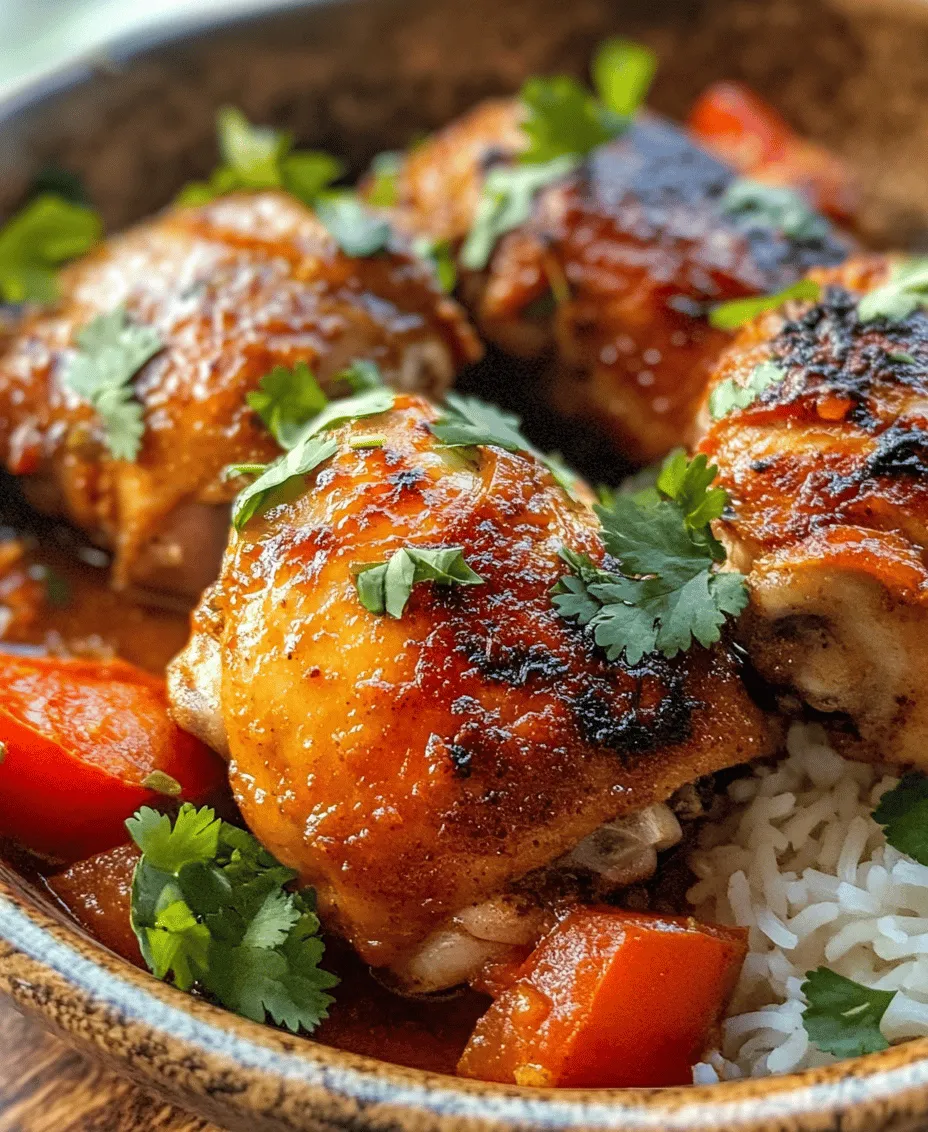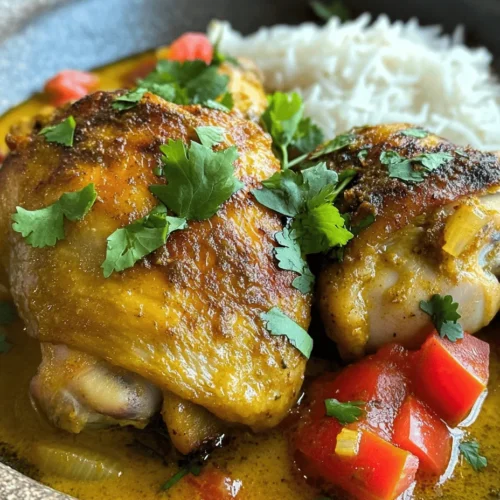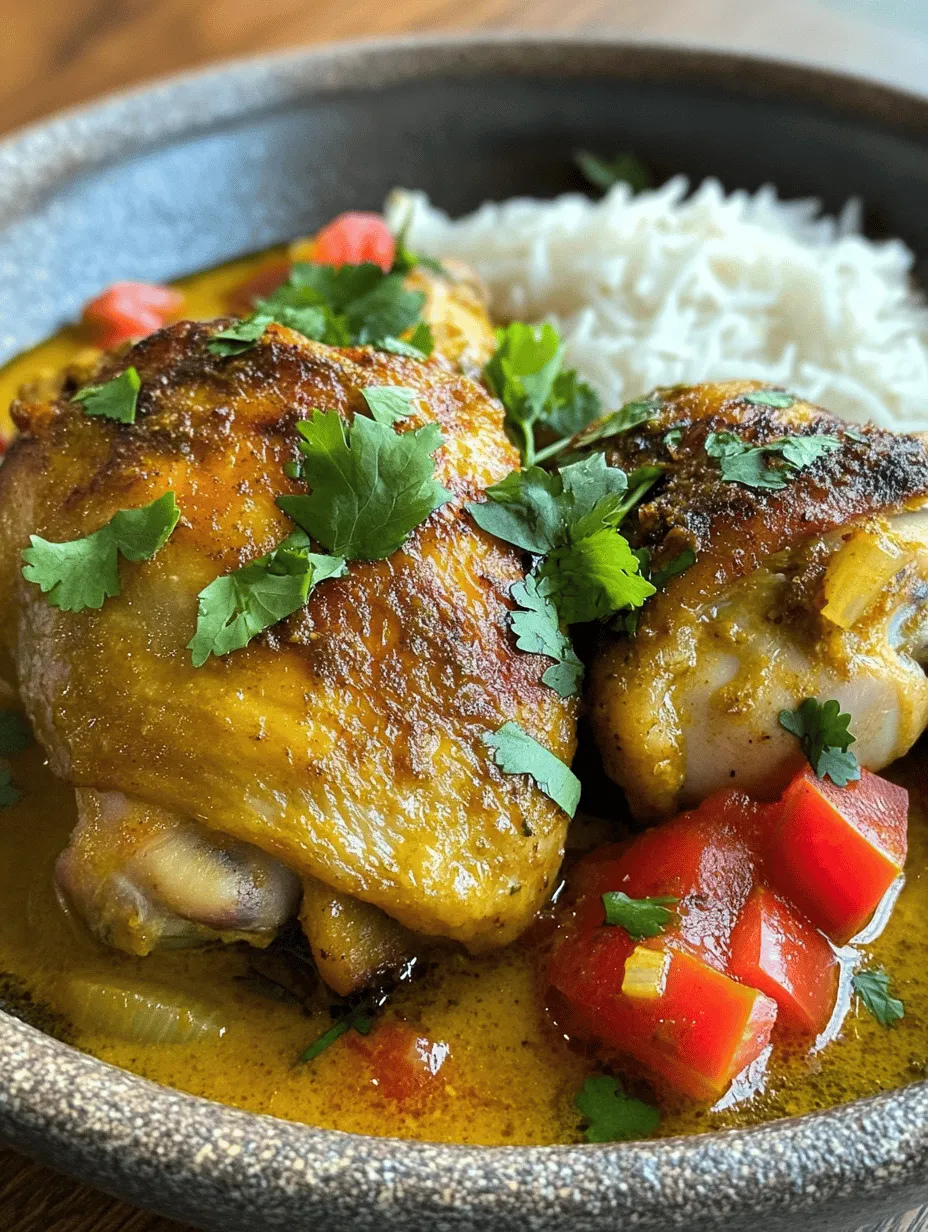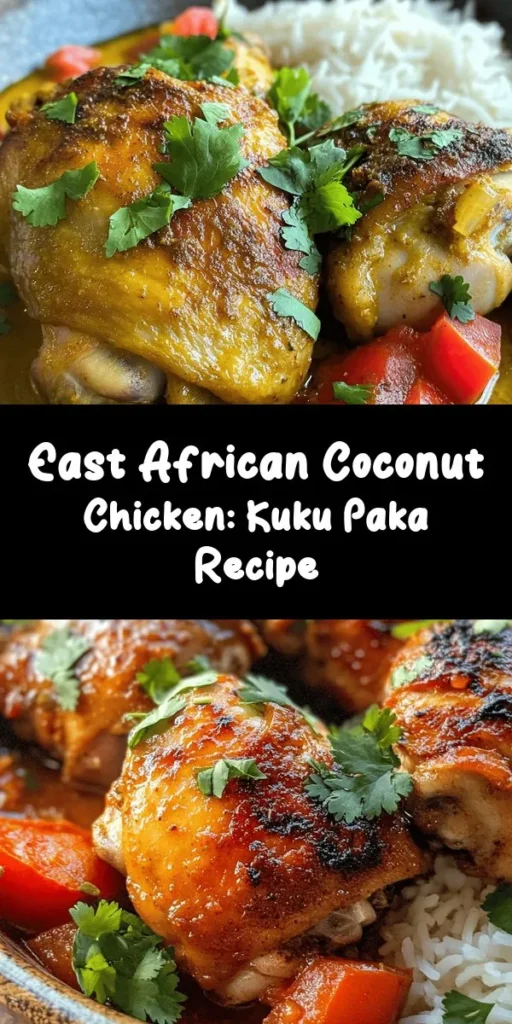Introduction
Kuku Paka is a vibrant dish that embodies the culinary heritage of East Africa, particularly popular in coastal regions such as Kenya and Tanzania. This delicious coconut chicken delight melds the rich flavors of coconut milk with a medley of spices, creating a dish that is both aromatic and satisfying. Kuku Paka not only showcases the abundance of local ingredients but also reflects the diverse cultural influences that have shaped East African cuisine over the centuries. As you delve into this recipe, you’ll discover how to recreate this beloved dish in your own kitchen, allowing you to experience the warm, welcoming flavors of East Africa.
The unique essence of Kuku Paka lies in its use of coconut milk, which imparts a creamy texture and subtle sweetness, perfectly balancing the spices that characterize the dish. It is a celebration of flavor, with each ingredient contributing to the overall harmony and depth. Whether enjoyed at a family gathering or on a cozy evening, Kuku Paka is sure to impress and satisfy.
In this article, we will guide you through the process of making Kuku Paka at home, starting from understanding the dish’s background and ingredients to the initial preparation steps. Get ready to embark on a culinary journey that brings the taste of East Africa to your table.
Understanding Kuku Paka
Definition and Origin of Kuku Paka
Kuku Paka, which translates to “chicken in coconut,” is a dish that epitomizes the fusion of African and Indian culinary traditions. The dish is believed to have originated from the Swahili coast, where Indian spices met local cooking methods, resulting in a unique blend that has become a staple in many East African households. This delightful chicken recipe is typically made with marinated chicken thighs, cooked in a rich coconut sauce, and served with rice or flatbreads, making it a versatile and hearty meal.
The Role of Coconut in East African Cooking
Coconut is a key ingredient in East African cuisine, particularly along the coastal regions where coconut palms thrive. The use of coconut milk not only enhances the flavor and texture of dishes but also adds nutritional benefits, including healthy fats and essential vitamins. In Kuku Paka, coconut milk serves as the base for the sauce, enveloping the chicken in a creamy, flavorful embrace that is both comforting and satisfying.
Cultural Variations and Regional Adaptations of the Dish
While Kuku Paka is widely recognized, various regions have their own interpretations of this dish. In some areas, it may be spiced with local herbs and seasonings, while others may incorporate different proteins or vegetables, showcasing the adaptability of the recipe. Additionally, the method of preparation can vary, with some opting for grilling the chicken before adding it to the coconut sauce, imparting a smoky flavor that complements the dish beautifully. Regardless of the variation, Kuku Paka remains a cherished dish that brings people together, celebrating cultural diversity and culinary creativity.
Ingredients Overview
Listing and Describing the Main Ingredients
To create a delicious Kuku Paka, you’ll need a selection of fresh ingredients that come together to form a rich and flavorful dish. The primary components include:
– Chicken Thighs: Chicken thighs are the preferred choice for Kuku Paka due to their rich flavor and tender texture. Using bone-in, skin-on thighs is essential, as the bones add depth to the broth while the skin crisps up during cooking, providing a delightful contrast to the creamy coconut sauce.
– Coconut Milk: The star ingredient of Kuku Paka, coconut milk, contributes a velvety texture and a hint of sweetness. It acts as the perfect canvas for the spices, creating a sauce that is both indulgent and refreshing.
– Aromatics: A combination of onion, garlic, and ginger forms the aromatic base of the dish. These ingredients work together to build a foundation of flavor, enhancing the overall profile of Kuku Paka.
– Spices: A blend of spices, including cumin, coriander, turmeric, and chili powder, adds warmth and complexity to the dish. Each spice contributes its unique character, resulting in a layered flavor experience that is sure to tantalize your taste buds.
– Fresh Ingredients: Fresh cilantro and tomatoes brighten the dish, adding a burst of color and freshness. Tomatoes, in particular, help balance the richness of the coconut milk, while cilantro provides a fragrant finish.
Explanation of Ingredient Substitutions for Dietary Restrictions
Kuku Paka is a versatile dish that can be adapted to suit various dietary needs. For those who prefer a vegetarian or vegan option, substituting chicken with firm tofu or chickpeas is a great alternative. In this case, ensure to adjust the cooking time accordingly. For those with coconut allergies, consider using almond milk or cashew cream as a substitute, although the flavor profile will change slightly. Additionally, if you are sensitive to spicy foods, you can reduce the amount of chili powder or omit it altogether, tailoring the dish to your personal taste.
Preparation Steps Explained
Marinating the Chicken
The first step in preparing Kuku Paka is marinating the chicken. Marination is crucial for flavor enhancement, allowing the spices and aromatics to penetrate the meat and infuse it with rich flavors. To achieve the best results, combine yogurt, spices, and a touch of salt in a bowl, creating a marinade that embraces the chicken thighs. Coat the chicken thoroughly and let it marinate for at least one hour, but ideally, overnight in the refrigerator. This time allows the flavors to meld and the chicken to become tender and juicy.
Suggested Marination Time for Optimal Flavor Absorption
For optimal flavor absorption, aim for a marination time of at least four hours. However, if time permits, letting the chicken marinate overnight will yield even better results, as the spices have more time to develop their flavors and penetrate the meat. This step is essential in creating a deeply flavorful Kuku Paka that will impress your family and friends.
Sautéing Aromatics
Once the chicken has marinated, the next step is sautéing the aromatics. Begin by heating a generous amount of oil in a large skillet or pot over medium heat. Add diced onions and sauté them until they turn translucent and slightly caramelized, which typically takes about 5-7 minutes. This step is vital, as properly sautéed onions lay the groundwork for a flavorful sauce.
As the onions cook, introduce minced garlic and grated ginger to the skillet. The combination of these aromatics will create an irresistible aroma that fills your kitchen. Sauté them for an additional 1-2 minutes, ensuring they don’t burn, as burnt garlic can impart a bitter flavor to the dish.
How Garlic and Ginger Contribute to the Overall Aroma
Garlic and ginger are not just flavor enhancers; they also add warmth and complexity to the dish. Garlic brings a savory depth, while ginger adds a hint of spice and brightness. Together, they create a fragrant base that elevates the entire dish, making it irresistible.
Cooking the Tomatoes
After the aromatics are perfectly sautéed, it’s time to add the tomatoes. Fresh, diced tomatoes are essential for achieving the right sauce consistency. The tomatoes will cook down and break apart, melding with the sautéed aromatics to create a rich, flavorful sauce. Cook the tomatoes for about 5-7 minutes, stirring occasionally, until they are soft and have released their juices.
This step is crucial as it not only adds moisture to the dish but also balances the richness of the coconut milk. Once the tomatoes have broken down, you’ll be ready to add the coconut milk and let the flavors meld together, resulting in a creamy and aromatic sauce that envelops the chicken.
In the next section of this article, we will continue with the cooking process, highlighting how to combine the marinated chicken with the coconut sauce and the final steps to create a mouthwatering Kuku Paka that’s sure to delight. Stay tuned!

Tips for Achieving the Right Texture and Flavor Balance
Creating the perfect Kuku Paka requires attention to detail, especially when it comes to achieving the right texture and flavor balance. The goal is to have tender, juicy chicken enveloped in a rich, creamy coconut sauce that is both aromatic and flavorful. Here are some expert tips to help you master this dish:
Cooking the Chicken
The first step in achieving a delicious Kuku Paka is to ensure that the chicken is cooked properly. Start by marinating the chicken in a blend of spices and coconut milk for at least one hour. This not only infuses the meat with flavor but also helps to tenderize it.
Techniques for Browning Chicken Properly
Browning the chicken is crucial for developing a deep flavor. Heat a large, heavy-bottomed pot or skillet over medium-high heat and add a few tablespoons of oil. Once the oil is shimmering, add the marinated chicken pieces in batches, ensuring not to overcrowd the pan. This allows the chicken to brown evenly rather than steam.
To achieve a beautifully browned exterior, let the chicken cook undisturbed for a few minutes before flipping it. This technique allows the Maillard reaction to take place, creating that desirable golden-brown crust.
Understanding the Maillard Reaction and Its Flavor Benefits
The Maillard reaction is a complex chemical process that occurs when proteins and sugars in food react under heat, leading to browning and the development of complex flavors. In Kuku Paka, this reaction is essential as it enhances the chicken’s taste, adding depth and richness to the final dish. Aim for a nice sear on the chicken before you proceed to the next steps, as this will set the flavor foundation for your coconut sauce.
Incorporating Coconut Milk
Once you have browned the chicken, it’s time to incorporate the coconut milk. Pour the marinade into the pot, scraping the bottom to deglaze and incorporate those flavorful browned bits. Coconut milk should be added gradually. Start with the thick cream from the top of the can, followed by the thinner milk.
How to Achieve the Desired Sauce Consistency
To achieve a perfectly balanced sauce, you want it to be creamy but not too thick. If your sauce seems too thick, you can add a bit of water or chicken broth to loosen it up. Conversely, if it’s too thin, allow it to simmer uncovered for a few minutes to help it thicken up naturally. The goal is to have a sauce that clings to the chicken without being overly runny.
The Effects of Coconut Milk on the Dish’s Flavor Profile
Coconut milk adds a unique sweetness and creaminess to Kuku Paka, which complements the spices beautifully. This rich ingredient helps to mellow out the heat from any chili peppers used and balances the savory flavors from the spices. If you prefer a more intense coconut flavor, consider using fresh coconut milk or a higher fat content variety.
Simmering for Flavor Development
After incorporating the coconut milk, reduce the heat and let the dish simmer gently. Simmering allows the flavors to meld together harmoniously. It’s a slow cooking process that transforms the chicken into a tender masterpiece while deepening the overall flavor profile.
The Science Behind Simmering and Its Impact on Texture and Taste
Simmering at a low temperature helps break down the proteins in the chicken, making it tender and juicy. This method also allows the spices to infuse into the chicken, creating a rich tapestry of flavors. Aim for a gentle simmer, as boiling can lead to tough chicken and an unbalanced flavor profile.
Signs to Look For to Ensure the Chicken is Properly Cooked
To ensure your chicken is cooked through, look for these signs: the juices should run clear when pierced, and the internal temperature should reach 165°F (75°C) if using a meat thermometer. Additionally, the chicken should be tender and easy to shred with a fork.
Final Seasoning Adjustments
Before serving, it’s crucial to taste your dish and adjust the seasoning as needed. This is an essential step to ensure that the flavors are balanced. If the sauce tastes flat, consider adding a pinch of salt, a squeeze of lime, or a dash of hot sauce to elevate the flavors.
Serving Suggestions
Kuku Paka is not just a dish; it’s an experience deeply rooted in East African culture. Here are some traditional accompaniments and serving tips to enhance your meal:
Traditional Accompaniments to Kuku Paka
Kuku Paka is traditionally served with a variety of sides that complement its rich flavors. The most common pairings include:
– Rice: Basmati or jasmine rice are excellent choices, as they absorb the coconut sauce beautifully.
– Chapati: This soft, unleavened flatbread is perfect for scooping up the chicken and sauce.
– Ugali: A staple in East African cuisine, this maize-based dish can provide a hearty base for the coconut chicken.
Suggested Side Dishes to Complement the Meal
Consider serving Kuku Paka with these side dishes to create a well-rounded meal:
– Kachumbari: A fresh tomato and onion salad that adds a refreshing crunch.
– Steamed Vegetables: Broccoli, carrots, or green beans can provide a nutritious contrast to the richness of the chicken.
– Samosas: These savory pastries can serve as a delightful appetizer.
Presentation Tips for a Visually Appealing Dish
To serve Kuku Paka in style, consider the following presentation tips:
– Use a large, shallow bowl to showcase the chicken and sauce.
– Garnish with freshly chopped cilantro or parsley for a pop of color.
– Serve with lime wedges on the side to allow guests to brighten their portions.
Cultural Context of Serving Kuku Paka in East African Households
In East African households, Kuku Paka is often served during gatherings and special occasions, emphasizing family and community. The dish embodies the warmth of hospitality, with each family having its own variations. Sharing this meal is a way to connect with loved ones and celebrate cultural heritage.
Nutritional Benefits of Kuku Paka
Understanding the nutritional value of Kuku Paka can enhance your appreciation for this dish. Here’s a breakdown of its components:
Breakdown of the Dish’s Nutritional Components
– Chicken: A great source of lean protein, essential for muscle growth and repair.
– Coconut Milk: Contains medium-chain fatty acids that may improve metabolism and provide quick energy.
– Spices: Ingredients like turmeric and ginger not only add flavor but also come with health benefits, including anti-inflammatory properties.
Health Benefits of Coconut Milk and Spices Used
Coconut milk is rich in vitamins C, E, and B vitamins, promoting overall health. The spices used in Kuku Paka, such as cumin, coriander, and turmeric, are known for their health benefits, potentially aiding in digestion and reducing inflammation.
Discussion on Portion Sizes and Serving Recommendations
For a balanced meal, consider serving Kuku Paka with one cup of rice and a side of vegetables. This ensures that you enjoy a variety of nutrients without overindulging. As with any dish, moderation is key.
Conclusion
Kuku Paka is more than just a dish; it’s a beautiful representation of East African culture, blending flavors and traditions into a delightful meal. With its rich coconut sauce, tender chicken, and aromatic spices, this recipe invites you to explore the culinary treasures of the region.
By preparing Kuku Paka, you not only enjoy a delicious meal but also connect with the vibrant culture of East Africa. We encourage you to try this recipe and share your experiences or variations with friends and family. Embrace the adventure of cooking and discover the joy of East African cuisine through Kuku Paka!



